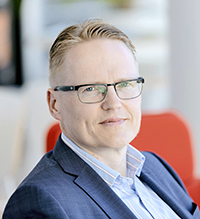 The energy revolution could be defined in several ways. The amount of renewable energy as a share of total energy generation – mainly wind and solar power – is increasing at an accelerating rate. Generation is becoming decentralised, with small, dispersed generating units, such as solar and wind power, alongside large plants. The advent of smart grids will transform consumers into prosumers. I have considered having solar panels fitted to the roof of my own home. I already have a wide range of other gadgets at home. We will see when the time feels right to make an investment.
The energy revolution could be defined in several ways. The amount of renewable energy as a share of total energy generation – mainly wind and solar power – is increasing at an accelerating rate. Generation is becoming decentralised, with small, dispersed generating units, such as solar and wind power, alongside large plants. The advent of smart grids will transform consumers into prosumers. I have considered having solar panels fitted to the roof of my own home. I already have a wide range of other gadgets at home. We will see when the time feels right to make an investment.
The government’s programme, published in June, paves the way towards a clean and cost-efficient power system. The programme includes clear targets for increasing the amount of wind power built on market terms, which will create the opportunity to improve Finland’s self-sufficiency in terms of electricity generation. Tax reforms, further developments of demand response and seasonal storage of electricity, and targets related to electricity, heating, transport and Nordic cooperation will drive Finland towards more climate-friendly solutions. Connections between energy systems in different sectors (electricity, heating and transport) will require the amount of renewable energy to increase substantially.
At present, Finland has approximately 2,100 megawatts of wind power generation attached to the network. Capacity of around 1,000 megawatts is under construction – on market terms and approved by auction. According to the Finnish Wind Power Association, the projects that have received permits, are under development or are pending a permit process account for almost 16,500 megawatts. Under the Electricity Market Act, Fingrid has an obligation to connect and develop, but it also has a strong desire to enable the large-scale connection of wind power.
How will Fingrid ensure that the transmission system is developed in a way that satisfies customers? Will Finland remain a uniform price area in an evolving energy landscape? I am responsible for ensuring that Fingrid has sufficient transmission capacity, and this is closely associated with network planning, construction and maintenance management. The transmission system investment programme has several projects in progress, aiming to ensure that the transmission system meets our customers’ needs. The 400-kilovolt Forest Line from Petäjävesi via Haapavesi to Muhos will increase the transmission capacity and enable clean energy to be connected to the transmission system further north in Finland so that the country can continue to have a single, uniform price area. The project is on schedule, and the first work contracts have been signed.
We are collaborating with the Swedish transmission system operator, Svenska kraftnät, to plan power lines from Northern Finland to Northern Sweden. The project has advanced to the environmental impact assessment phase. The replacement of the Iron Lady, Finland’s oldest power line, will be complete when the Hikiä–Orimattila line (400 kV) is commissioned at the end of this year. The ageing 400-kilovolt switching station in Olkiluoto was replaced in June by two separate plants, which will ensure better operational reliability.
As this indicates, it is our assumption that new wind power providers will be made on market terms more rapidly and in larger numbers than before. We are prepared for this and we are constantly improving our capabilities. Our Customer Managers are engaged in proactive dialogue with customers all the time. We are offering new connection opportunities, increasing the flexibility of the investment programme by conducting environmental impact assessments and pre-emptively purchasing land, clarifying the routes for transporting transformers, preparing projects in advance, bundling purchases, exercising options and further standardising our technical solutions. In other words, we are improving process lead-throughs, enabling us to respond to the new market dynamics.
So yes: we are ready to face down the challenge and do everything necessary to ensure Finland has the world’s best, most cost-efficient electricity transmission system.
Timo Kiiveri
Director, Asset Management Fingrid






